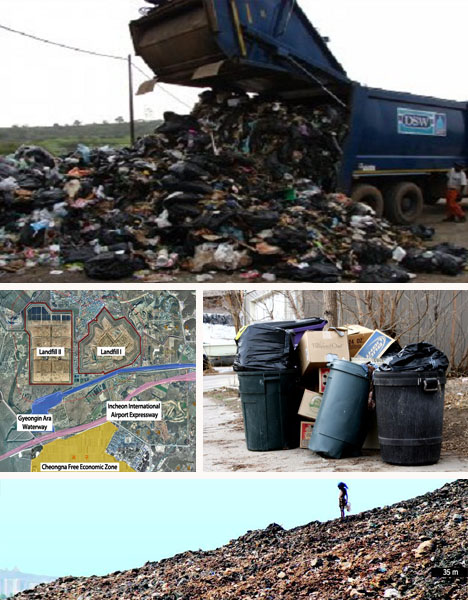
Bisasar Road
Location: Durban, South Africa
Size: 109 acres (1 acre = 4,840 square yards)
Date opened: 1980
Waste processed daily: 5,000 tons
Bad rep: Located on the site of a once rich nature reserve,
the Bisasar landfill was never set up to properly address the release of harmful gases, heavy metals or other types of carcinogenic pollutants. Consequently, toxic air emissions as well as water- and soil-transmitted pollutants have exposed local residents to record rates of cancer and other serious ailments.
Eco-distinction: Each month,
well beyond 3 million Nm3 of landfill-generated methane is combusted in order to create electricity (and carbon credits).
Deonar Landfill
Location: Mumbai, India
Size: 300+ acres
Date opened: 1927
Waste processed daily: 2,200 tons
Bad rep: Typically, landfills reach maximum capacity within the span of three decades before they are closed. Deonar, however, continues going the distance (80+ years and running), the unfortunate result being that some areas within the site tower as high as nine-story buildings. Additionally, its
too-close-for-comfort location next to multiple residential areas has resulted in soaring respiratory issues among the population.
Eco-distinction
: In response to the ongoing Deonar debacle, the Brihanmumbai Municipal Corporation is in the process of creating a material recovery facility — the first of its kind in Mumbai — that is expressly designed to process recyclable material.
Jardim Gramacho
Location: Rio de Janeiro
Size: 321 acres (equivalent to approximately 247 football fields)
Date opened: 1978
Waste processed daily:
8,000 tons
Bad rep: On the verge of closing, this decades-old landfill, created on biodiverse wetlands, has long been referred to as an “environmental crime” because
liquid waste continues polluting nearby Guanabara Bay.
Eco-distinction
: Jardim Gramacho was featured in Lucy Walker’s
Waste Land, a film that documented the lives of several
catadores (garbage pickers) and the efforts of artist
Vik Muniz to transform their future through the creation of larger-than-life recycled waste portraits.
Puente Hills Landfill
Location: Whittier, CA
Size: 700 acres (640 acres = 1 square mile/1,760 yards/5,280 feet)
Date opened: 1957
Waste processed daily: Up to 13,200 tons!
Bad rep: On track to officially close in 2013, America’s largest landfill purportedly soars as high as a skyscraper and
can be seen quite effortlessly via Google Earth.
Eco-distinction
: This waste facility, like so many others included in this article, harvests methane released from landfill trash and then burns the gas in order to provide
green electricity for 70,000+ local residents. Interestingly, Puente Hills also funds
The Puente Hills Landfill Native Habitat Preservation Authority. Among its most well-intentioned projects, various wildlife corridors were created for the safe passage of animals in heavily trafficked areas, but alas, high casualty rates have yielded far more criticism for the effort than applause.
Laogang Landfill
Location: Shanghai, China
Size: 1,000+ acres
Date opened: 1990
Waste processed daily:
10,000 tons
Bad rep: Not content to remain on land, the Laogang Landfill continues creeping closer toward the ocean thanks to the diligent efforts of workers entrusted with the task of creating ever-expanding waste accommodating dams.
Eco-distinction
: Laogang’s ongoing methane-gas-to-energy project, the largest in China, utilizes
12 electricity-generating, methane-fueled turbines constructed by Veolia Green Technology.
Apex Regional Landfill
Location: Las Vegas
Size: 2,300 acres
Date opened: 1993
Waste processed daily:
9,000 tons
Bad rep: Blame booming Sin City construction for all-time sky-high rates of waste disposal at this particular landfill — an astounding 15,000 tons every single day during 2007 and 2008.
Eco-distinction: Quite recently, Apex Regional finally greened up its act by
unveiling a 12-megawatt power station that will ultimately generate enough incinerated waste-to-energy to keep 10,000 residents powered up.
Sudokwon Landfill
Location: Incheon, South Korea
Size: 5,130 acres
Date opened: 1992
Waste processed daily: 13,500 tons
Bad rep: Compared to other waste facilities of its size, Sudokwon Landfill, which was constructed with little forethought and poor execution, is continually blamed for the
release of excess leachate into the surrounding environment.
Eco-distinction
: Sudokwon is home to the
largest gas power plant in the world, generating enough energy to power 180,000+ households. Additionally, previously closed sections of the landfill are now being converted in a
comprehensive, environmental-themed park complex.

